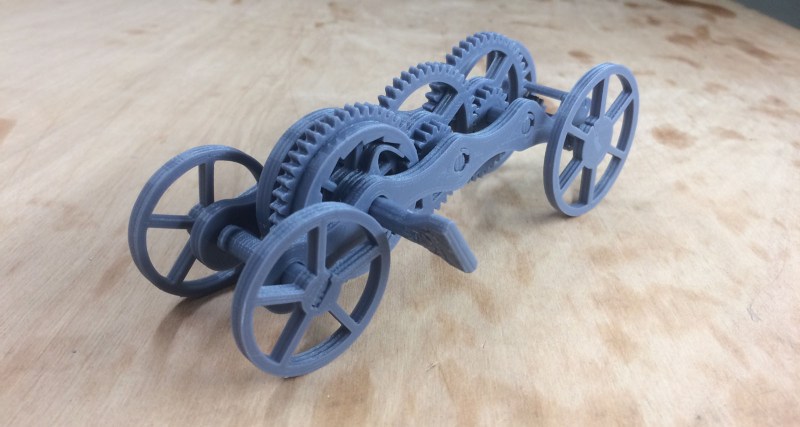For a hundred years or thereabouts, if you made something out of plastic, you used a mold. Your part would come out of the mold with sprues and flash that had to be removed. Somewhere along the way, someone realized you could use these sprues to hold parts in a frame, and a while later the plastic model was invented. Brilliant. Fast forward a few decades and you have 3D printing. There’s still plastic waste in 3D printing, but it’s in the form of wasteful supports. What if someone designed a 3D printable object like a flat-pack plastic model? That’s what you get when you make a Fully 3D-printable wind up car, just as [Brian Brocken] did. It’s his entry for the Hackaday Prize this year, and it prints out as completely flat parts that snap together into a 3D model.
This 3D model is a fairly standard wind-up car with a plastic spring, escapement, and gear train to drive the rear wheels. Mechanically, there’s nothing too interesting here apart from some nice gears and wheels designed in Fusion 360. Where this build gets serious is how everything is placed on the printer. Every part is contained in one of two frames, laid out to resemble the panels of parts in a traditional plastic model.
These frames, or sprue trees, or whatever we’re calling this technique in the land of 3D printing, form a system of supports that keep all the parts contained until this kit is ready to be assembled. It’s effectively a 3D printable gift card, flat packed for your convenience and ease of shipping. A great project, and one that proves there’s still some innovation left in the world of 3D printing.
















“A great project, and one that proves there’s still some innovation left in the world of 3D printing.”
Benchoff is apparently too much of a grinch to know about the following:
https://www.thingiverse.com/thing:2722687
Merry XMAS kids
Thanks for the link
or this one https://www.thingiverse.com/thing:1985600
Or this one https://www.thingiverse.com/thing:3237742
yeah but those others are -yawn- . this makes a wind-up car! Much cooler.
Seems to me the 3d print analogue of the sprue-frame would be to design breakaway supports to build multiple parts together in a stack/cube, ready for the recipient to break out the parts when they get it.
That gives you another dimension of plastic to sand!
I made one of these right after it came out. It worked pretty well, I just had to taper the points on the inside part of the ratchet mechanism. It’s points that are meant to lock against the ratchet teeth also caught against the frame. Couldn’t push them down into it enough that they never catch so I used an xacto to cut an angle so if they hit on the side they don’t stick.
One of the 3D printing noobs at the makerspace wanted to make some sort of robot with a cylindrical gun turret from which the gun would rise and then aim at the target. He was going to 3D print a cylinder about 8″ in diameter and 18″ high. I suggested that using off the shelf tubing such as a sonotube would make a lot more sense.
I won’t deny that this project is a clever design, but it would seem to make more sense to start with an already mass manufactured flat material like plywood or polycarbonate, and then cut it apart with a jigsaw or laser cutter.
+1
some times subtraction is the right way to go
Sweet, man. Looks like a lot of design, prototype and delayed gratification
This is neat way to make business card, we make airplane graphics and have designed a plane model that pops out of a frame for assembly.
It’s not self propelled, but tiny and if looks great : https://www.thingiverse.com/thing:714484
We need a flat-pack benchy!
most parts on these could easily be lasercut. I think someone should make a tutorial on “convert flat 3D printable STLs into DXF quickly”… maybe I will do it someday =)